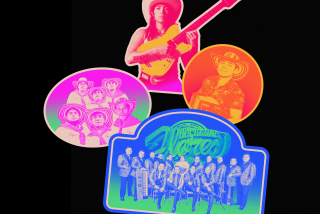The Rebirth of an Ancient Korean Art Form
Anyone hearing the dynamic drumming of Korean folk music would hardly believe this exciting art once was on the verge of dying out. But that’s precisely why Kim Duk Soo founded his troupe, Samulnori, in 1978.
“A long time ago, there were many professional groups of wandering entertainers who would not only play this kind of music, but also perform masked dances, acrobatics and shamanistic rituals,” Kim said recently.
“They would go from village to village, improvising in any open area and performing rituals that would bring both heaven and Earth into harmony. People would feast, sell their wares and celebrate life. It was a carnival and bazaar all rolled into one.”
But because of changes in Korea, “the advent of TV and radio and other kinds of Westernization,” Kim said, “and also the Japanese occupation and the Korean War, these traditions were uprooted and relegated to mythology.”
A descendant of a line of such wandering entertainers, or namsadang, Kim, 45, was speaking through a translator from Olympia, Wash., prior to company stops in Los Angeles, Costa Mesa and Cerritos.
“We wanted to give that sense of life and dynamic atmosphere. But what was played on an open field now had to be played on a stage. So I had to reinvent, rearrange and revive this tradition to fit the next generation. But we kept the original four instruments that have always been used.”
*
In fact, the name of the troupe literally means “to play four things.” The four things are musical instruments, each associated with an element in nature. Kkwaenggwari, a small gong, represents lightning. Ching, a large gong, represents wind. Changgo, an hourglass drum, represents rain; and Puk, a barrel drum, represents clouds.
The musicians not only play these instruments, but also dance with them, setting up complex drumming patterns that are mirrored in dynamic footwork, knee drops and high-velocity spins. All this is often accented by the musicians’ flicking streamers, which are attached to their hats in pinwheel patterns around their heads.
The troupe has visited the Southland periodically for the last decade. Its success since its first concert in a small studio in Seoul has prompted it recently to expand from an initial troupe of four to 30 artists and students today. In 1993, it became a nonprofit organization called Samulnori Hanullim. (“Hanullim” means, appropriately, “big bang.”)
The purpose remains the same, however. “We want to promote and educate people about Samulnori and Korean music and to make Korean music and Samulnori a world music,” Kim said. “We felt a nonprofit organization would better serve that purpose.”
The organization comprises three groups. One is a young people’s performing company, which is touring in France. “This will lead us into the next century, the next generation,” Kim said.
It also includes the Samulnori troupe itself and a third group, Menari, which incorporates dance, song, instrumental music and shamanistic traditions.
“Many regions of Korea have different flavors of shamanism,” Kim said. “Although in recent years Buddhism and Christianity have much influenced the Korean religious mentality, shamanism still permeates the culture. It’s always part of the basic traditions of life--weddings, funerals and farming festivals, of course. . . .
*
“There are many deities and spirits [in shamanism], but more important is the idea of living in harmony between nature and man and within mankind itself. It’s a humanistic belief. The shaman law was to entertain in a way that both heaven and Earth can be harmonized. That was the rule of performances then, to give some kind of performance that would give some kind of revelation.”
So famous has Samulnori become that its name has been adopted generically for this kind of music and dance performance. So there are now many other samulnori groups, in Korea and in other countries.
*
Kim isn’t bothered by the imitations.
“I was not terribly surprised by the success of the company,” he said. “I’m glad that many people can make a living doing this music. In some ways that was what I expected and hoped for, that people can refind their roots and bring back the harmony of the old age.”
* The Samulnori troupe dancers and drummers of Korea will appear in concert on Saturday at 8 p.m. at the Orange County Performing Arts Center, 600 Town Center Drive, Costa Mesa. The program is sponsored by the Philharmonic Society and the Performing Arts Center. $10 to $37. (714) 553-2422. The company also will dance Friday at 8 p.m. at the Veterans Wadsworth Theater, Veterans Administration grounds, Brentwood. $9 to $26.50. (310) 825-2101. The troupe will appear Feb. 7 and 8 at 8 p.m. at the Cerritos Center for the Performing Arts, 12700 Center Court Drive, Cerritos. $16 to $20. (800) 300-4345.
More to Read
The biggest entertainment stories
Get our big stories about Hollywood, film, television, music, arts, culture and more right in your inbox as soon as they publish.
You may occasionally receive promotional content from the Los Angeles Times.










